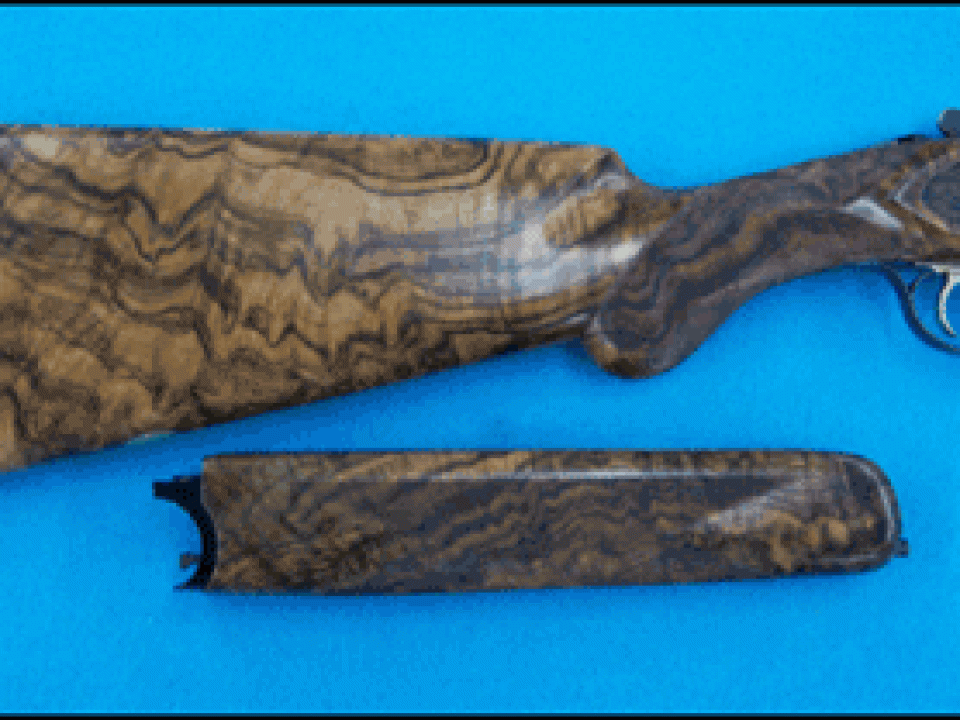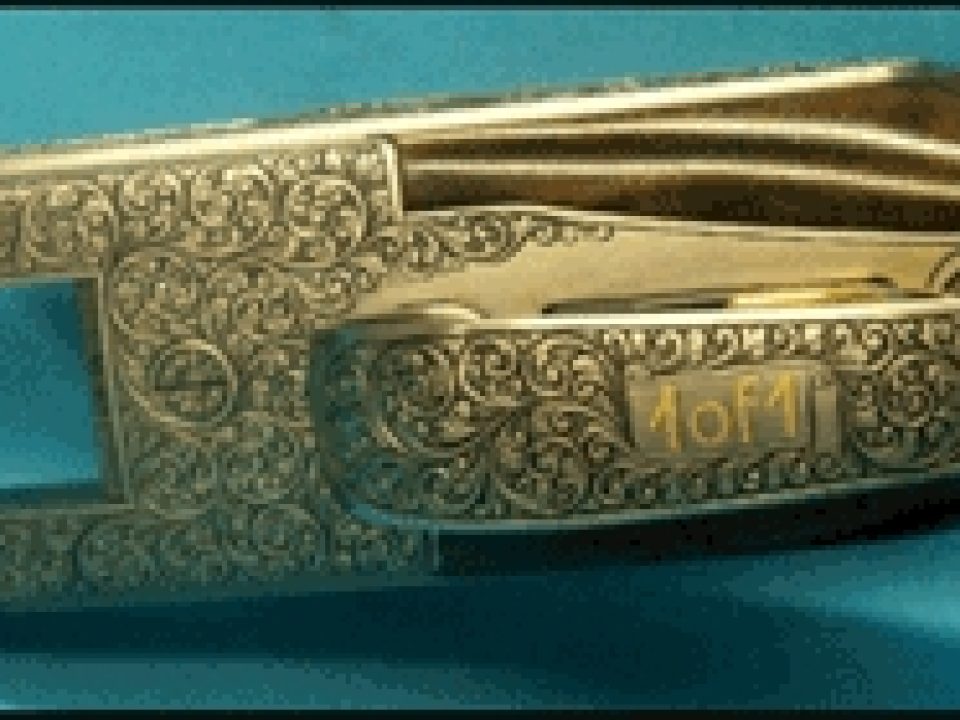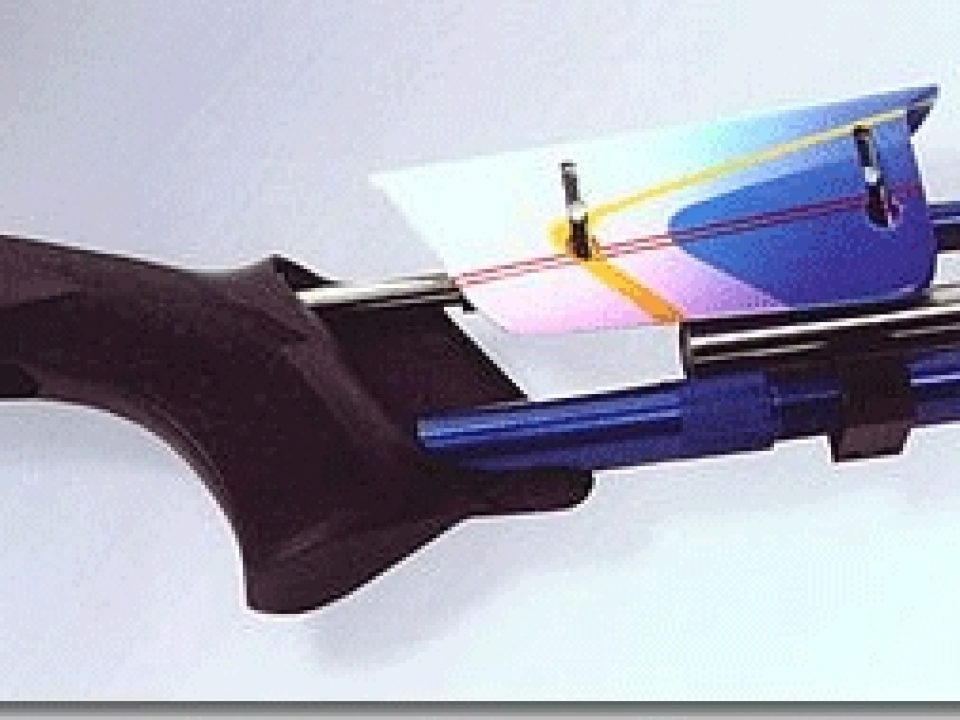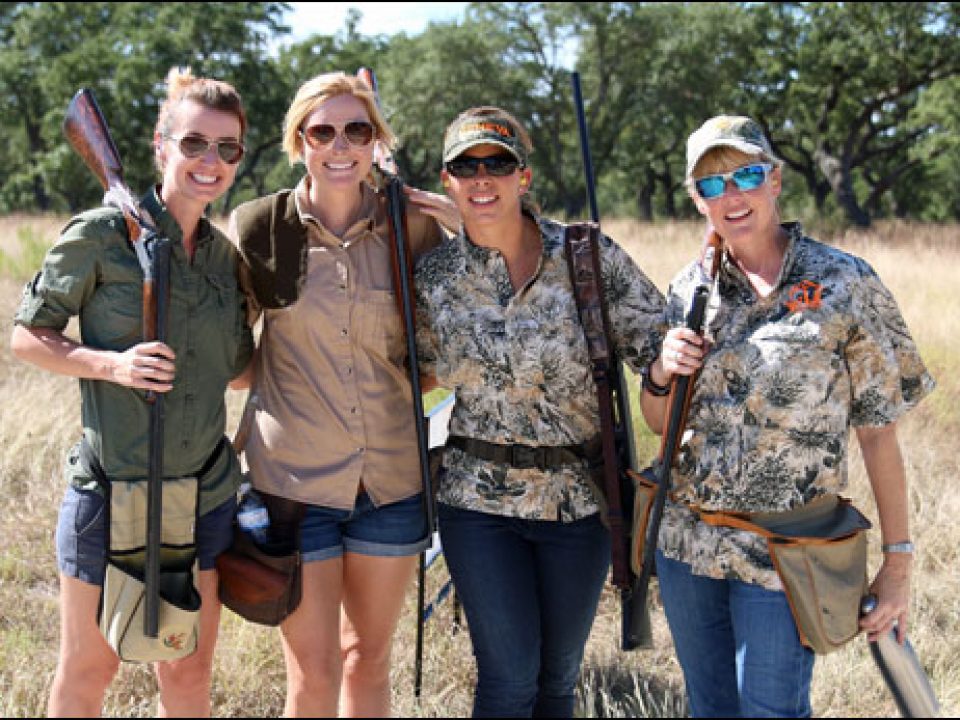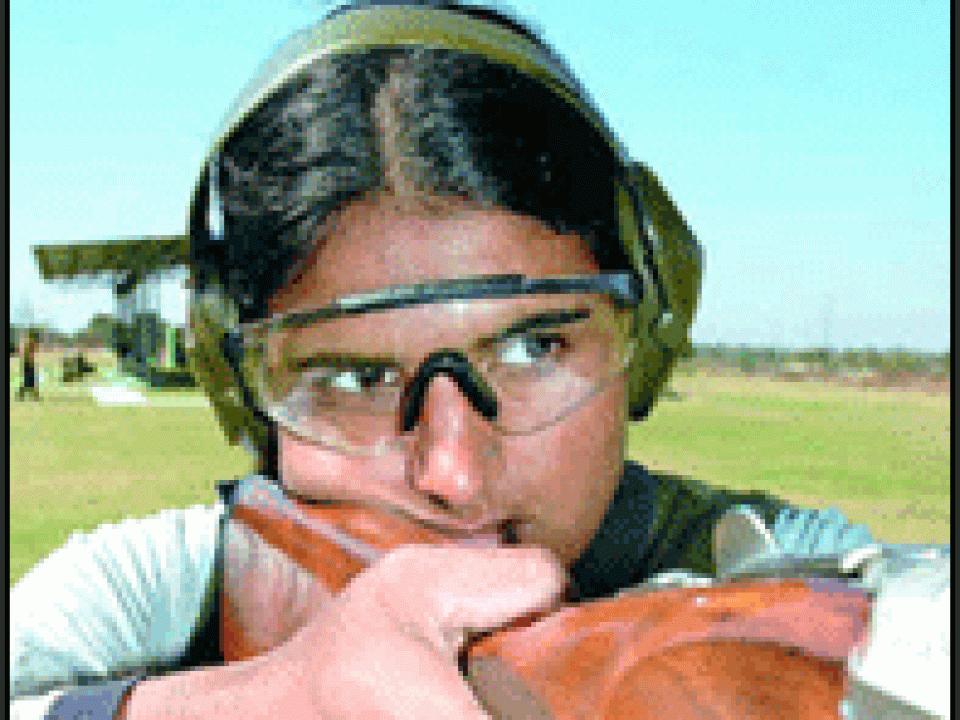To advertise with Shotgun Life, please contact advertising@shotgunlife.com or call (410) 484-2038.
shotgun
Robert James and The Point of Impact
Robert James pulls no punches: “I’m really upset with the shooting industry, including myself,” he says.
What could possibly rile the likes of Mr. James, a 75-year-old master stock maker?
The Most Expensive Blaser F3 in the World?
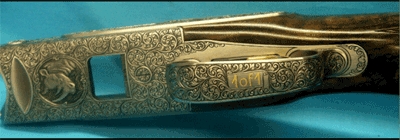
At $50,200 this custom Blaser shotgun may be the most expensive F3 ever produced by the company.
When you consider the top F3 Imperial lists for nearly $29,000, this custom F3, which we call One-of-One because of its trigger-guard inscription, becomes worthy of recognition.
A Conversation With Tullio Fabbri
By Irwin Greenstein
Meet Tullio Fabbri, shotgun maker to the stars.
His clients include director Steven Spielberg, actor Tom Selleck, rocker Eric Clapton and writer-director John Milus.
“A lot of very, very wealthy people in the public eye are Fabbri owners,” noted Mike Burnett, manager of Dewings Fly & Gun Shop in West Palm, Florida, the only authorized Fabbri dealer in the world.
That’s because Fabbri shotguns are recognized as the pinnacle of shotgun achievement. Fabbris are technically perfect, and with their stunning Renaissance and fantasy-style engravings are truly “functional artwork,” said Mr. Burnett.
A Matched Pair for $395,000
Today you can purchase a matched pair of new 12-gauge Fabbris selling for a cool $395,000 on the Dewings web site (simply click on the “Add to Cart” button). The starting price for a new Fabbri is $100,000 — and the waiting list can be up to five, very long years for a bespoke shotgun.
You can of course sidestep the queue and find yourself a previously owned Fabbri. Even then, you can expect to pay $60,000 to $240,000.
Or you can talk with Mr. Burnett. He has reserved time with the engravers and has several Fabbris in the pipeline whose stocks he could custom fit during production. In that case, your wait would be approximately 15 months. If you can accommodate an off-the-rack Fabbri, Mr. Burnett had six in his store as of this writing — among the largest retail inventories of Fabbris anywhere.
The Fabbri Vision
The scarcity, quality and star-power of Fabbris elevates them into the same rarefied universe as the British legends: Purdy, Holland & Holland and Boss. Yet while these institutions have been making shotguns for hundreds of years, Mr. Fabbri’s father, Ivo, started the firm in 1965. The remarkable trajectory of Fabbri is a testament to the craftsmanship and vision that catapulted this tiny shotgun company straight to the top.
So what is the secret to a Fabbri shotgun?
Mr. Fabbri was kind enough to spend about 30 minutes on the phone with us from Italy, to explain the philosophy of the company.
“We have to use anything we can afford to do our job better,” he said. “The design and mechanics of our guns change according to new technology.”
The payoff, according to Mr. Burnett is “The details. A Fabbri gun is absolutely perfect. Not a flaw, not a burr, not anything that would cause that gun mechanical failure. They are mechanically perfect, and as close to perfection in an over-and-under shotgun there is.”
Only 30 Fabbris per Year
As a matter of course, Fabbri has been at the forefront of computerization and advanced manufacturing — an approach that some critics judge as extreme when you consider that the business employs only 16 people who make approximately 30 shotguns per year.
For example, he will use one of these $10-million machines to make a single screw from scratch, explained Mr. Burnett.
“A lot of people don’t appreciate the effort we put into our shotguns,” Mr. Fabbri said. “We keep working very hard to make improvements. The design of the gun is alive — it’s a laboratory for people who really want the best.”
Like a Silicon Valley Clean Room
In his quest, Mr. Fabbri broke ground in 2004 on a new facility that could rival the semiconductor clean rooms of Silicon Valley — a place he knows quite well from his frequent visits to test and try new equipment for his shop.
Fabbri’s 50,000-square-foot factory is climate controlled. It uses 3-D software for design and manufacturing — similar to what the big car makers employ to see renditions of parts and designs in 360º before committing them to production.
Laser-Welded Barrels
Mr. Fabbri has opted to laser-weld the barrels for enhanced precision. The sears in the locks are coated with a diamond dust finish for durability. Materials for making a Fabbri shotgun include titanium alloys and stainless steel for strength and agility. All 150 individual parts of a shotgun are manufactured in the Fabbri workshop — an entire shotgun completing a rigorous 1,500 production steps.
Unlike his pricy British counterparts, Mr. Fabbri is unapologetic that his exquisite over-under shotguns are machine-made. In fact, he believes it’s the best way to make the best possible shotguns.
“We make a 12-gauge that weighs like a 20,” he said. “It’s perfectly balanced. You can’t do that with a file, anvil and drill.”
Fabbri is still blazing a path set in the 16th century of the Val Trompia region of Italy, where the company is located.
The Craftsmen of Val Trompia
Val Trompia is reknown for its Italian craftsmen who have been plying their weaponry skills since Bartolomeo Beretta started making barrels for the arquebus, a heavy matchlock gun favored by kings and popes.
The narrow valley of Val Trompia runs through the Columbine Mountains. The region is rich in high-grade iron ore and timber that fueled the furnaces and fire pits of the earliest artisans. The Mella River which flows through the valley supplied water and hydro power.
This rustic area has been at the leading edge of weapons development for centuries. It is home to Beretta, Franchi and an astonishing concentration of gun-making expertise.
The raw materials of the mountains enabled the Berettas to work the small fires that shaped rough plates heated and wrapped around steel mandrels. It marked the beginning of the fine art of welding the seam along the length of the barrel by hammering the overlapping edges together.
The Brescian Style
Over the centuries, magnificent guns and armor of Val Trompia were manufactured with intricate embellishments chiseled into their design. It came to be referred to as the Brescian style — in acknowledgement of the nearby industrial hub of Brescia.
Val Trompia was relied upon to keep Napoleon’s Grand Army in guns. Almost 40,000 muskets were produced annually until Napoleon was brought to his knees in 1815.
Today, the Val Trompia region is a Mecca for engravers. This ancient mountain region is now home of Sabbati, Pedretti, Torcoli and Pedersoli. How much are collectors willing to pay for Fabbris engraved by these masters? Well, that $395,000 matched pair on the Dewings web site was engraved by the legendary Mr. Pedersoli. An engraving by Mr. Perdersoli can easily add $50,000 or more to the price of a base, $100,000 Fabbri, Mr. Burnett told us.
That’s why it’s hard to believe that the Fabbri phenomenon could have happened anyplace else in Italy.
An Italian Feast of Shotgun Makers
The Brescia Consortium of Arms Manufacturers touts over 30 world-class shotgun manufacturers plus more than 40 subcontractors — the artisans who specialize in barrels, triggers, stocks, engraving and other components that are scrupulously manufactured.
Go down the list of shotgun makers in the consortium and you’ll see Italian legends such as Pedersoli, F.A.I.R., Famars, Piotti, Rizzini, Zoli and others. And it is very similar to the concentration of talent that you find in Silicon Valley where tradition, genius and proximity give rise to a hotbed of innovation.
When you visit Val Trompia, it seems like every Italian gun maker in the country is housed here.
Now, when you think of the specialization that marks so many craftsmen in the area, Mr. Fabbri has taken that 16th century craftsmanship into the space age.
As Mr. Burnett explains, “Basically when you buy a Fabbri you’re paying for the labor. Tullio makes every part in house.”
The Maestros
Mr. Fabbri deftly walks the high wire that spans digital manufacturing and old-world craftsmanship. Ask him who engraves his shotguns, and you’ll get a Who’s Who of Italian Maestros…Angelo Galeazzi, Gianfranco Pedersoli and Manrico Torcoli (the father of the fantasy style of engraving), among others.Mr. Burnett said his customers buy Fabbris for different reasons, but mostly they see these shotgun masterpieces as investments. “They’re not going to lose money — they’re so sought after. You could probably make 10% year over year on a Fabbri.”
Art of the Gun
In this section we celebrate the great engravers, stock makers and craftsmen who combine their talents to produce beautiful shotguns.
Since the 16th century, guns have been adorned with depictions of great hunts and battles. Now in the 21st century you’ll come to understand that, with the right talent, a shotgun can actually become a piece of jewelry — something that distinguishes the owner and enhances the value of the shotgun.
Prepare to be amazed.
Shotgun Fit: What You’re Missing
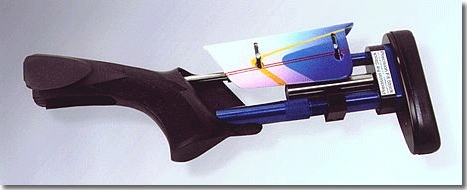
A proper fitting shotgun is so important that some folks are willing to spend $90,000 and more to get it. For that $90,000, you can take possession of a bespoke Purdey side-by-side custom fit to you much as the company did to the British landed gentry in the 19th century.
But for shooters who don’t have the money or the time to wait 12 long months for their shotguns, you can fit an off-the-shelf shotgun to your frame in ways that will enable you to hit plenty of targets — consistently.
Ask the experts about purchasing a shotgun and the first thing they’ll advise is to make sure it fits. In this section you’ll find everything necessary to help you understand the dynamics of a well-fitting shotgun…
- What to look for
- Eye domination
- Trigger pull
- Adjustable combs
- Adjustable butt plates
- Common mistakes
- Low gun fit
Cleaning Your Shotgun (Or Not)
Do you really need to clean your shotgun?
You’d be surprised that the answer is: “It depends.”
One 50-year veteran shooter will hardly ever clean his over/under. He’ll go shoot birds in Argentina with a dirty shotgun, spend a few days shooting 4,000 rounds or so — and just keep on shooting without a drop of Hoppe’s ever touching it.
Then there are shotgun owners with semi-automatics that need to give it a good cleaning every 300 rounds or so.
And then of course there are shooters who clean their shotguns after a few rounds of skeet.
What’s right? What’s wrong? Well, it depends.
In this section you learn the ins and outs of proper shotgun care…
- The importance of a clean shotgun
- Products that do the job
Women and Shotguns
Caution ladies: If your husband or boyfriend hands you one of his old shotguns for a round of clays shooting, say “Thanks but no thanks.”
Anecdotal evidence points to the above situation as a sure-fire way for a woman to never pick up a shotgun for the rest of her life. Why?
Women Shooters
You’ve spoken, we’ve listened, and now we’re here to champion your cause.
On the skeet field, on the sporting clays course or out on a driven pheasant shoot, women say that men can be a real pain in the stock butt. Men either gush with gratuitous and contradictory advice, or they pretend that the women shooting next to them simply don’t exist.
And then there’s the gun makers. When the heck are they going to wake up and make a shotgun for small-framed women that has a 13-inch length of pull?
But the clock is ticking and women’s influence on the shotgun industry is about to be felt — big time.
Across the sports of trap, skeet and sporting clays, the number of female participants age 12-17 rose 56 percent-from 133,000 to 208,000-between 1999 and 2004. The upward trend also has been seen in the National Shooting Sports Foundation’s (NSSF) Scholastic Clay Target Program (SCTP), which in 2005 alone saw an 84 percent increase in participation by girls from elementary through high-school age.
Judy Rhodes: Texas Shooting Diva
If anyone deserves to be a Texas shooting diva, it’s Judy Rhodes.
A rancher’s daughter, Judy has been toting a gun since the age of four (she started with a Red Ryder B-B gun in Rockwall County, Texas).
Maybe her calling as a cheerleader for the shooting sports started when she became a majorette in school; after practice or a game, she would go dove hunting with her friends.
Fast forward to1999, when Judy was recruited to the board of the Women’s Shooting Sports Foundation — an arm of the National Shooting Sports Foundation (www.nssf.org). The charter of the WSSF was to get women more involved in the shooting sports and hunting, as well as function as sort of a lobbying group to influence manufacturers and retailers on the special needs of women shooters (and Judy has some strong opinions about that).
At the same time, Judy started the Texas Women’s Shooting Sports/DIVAS. Today, DIVAS has members in 48 states and 14 foreign countries. Over the years, DIVAS has taught over 800 women how to shoot a shotgun.
Her motto is “Women Helping Women…Women Teaching Women…Women Supporting Women.” Her leadership in shooting, hunting and civic organizations led to a major story with photograph (including shotgun) in the Today Section of USA Today in March 2006.
She has also been featured in stories promoting women’s positive outdoor experiences throughout the world, including broadcasts on German Television and the United Kingdom BBC Television.
Maybe that’s where she got the TV bug. She started Divas in the Outdoors Television Show for reaching women and families worldwide. The show teaches simple techniques from professionals. Divas in the Outdoors is the number-two show on MOR (Men’s Outdoors and Recreational) shown on Direct TV, DishNetwork, Comcast and Turner Media.
All the while, Judy has been to South Africa 18 times, in addition to Spain, Argentina, Scotland, England, Canada and Mexico, as well as all over the U.S.A.
Her leadership, enthusiasm and commitment have made Judy the voice of outdoor women within the industry. As you can appreciate, she has a word or two for shotgun makers.
“Make guns that fit us.”
Judy believes that the Beretta 391 semi-automatic is probably the best-fitting full-size gun for women on the market. Otherwise, she recommends that smaller framed women get themselves a youth gun.
But knowing Judy, we can expect to see a lot more shotguns on the market tailored to women.
Lisa Snelling: Woman Hunter
Lisa Snelling is on the vanguard of women shooters.
When she was a newcomer to the sport, Lisa searched for information that she simply couldn’t find in the numerous male-oriented hunting magazines that line the racks. So like many women pioneers, she took the initiative and launched The Woman Hunter (www.womanhunter.com), an online hunting magazine and social networking site for female hunters.
While some women would be satisfied with that accomplishment alone, Lisa, secretary of Camo & Lace, a non-profit organization that introduces women to the outdoors.(www.camoandlace.net) also organized one of the largest all female skeet leagues in the state of Michigan.
If you want hunter education courses designed for women and taught by women, Camo & Lace is the place to be. Women learn about shotgun shooting, birding, camping, fishing, hiking, wild game cooking, ATVing and other outdoor-related activities.
As Lisa tells it, many outdoors programs for women focus on only introducing them to the sport. Camo and Lace wants to take it to the next level: bringing women into a supportive group that meets on a regular basis. The league helps them achieve this goal.
The skeet league provides women a place where they can learn how to shoot in a comfortable and encouraging environment. The league meets every year in August for ten weeks at the Grand Blanc Huntsman’s Club in Atlas Township, Michigan. Women who have never shot before or who do not own a gun are encouraged to attend.
The benefits are cumulative. The female bonding of Camo and Lace helps nurture self-confidence and self-esteem that so many women gain from shooting. And while women can join a bowling league or go the cosmetics counter for a makeover, Lisa believes that nothing matches the confidence-building of being a good shot.
She knows it first hand. In Argentina, she was one of an elite group of shooters who downed 1,000 doves in a single day.
Cindy McCrory, co-owner, MizMac Designs
Cindy McCrory has something to tell you men shotgunners out there: “Get over it.”
Women shotgun shooters are here to stay.
If any woman has earned her stripes on getting women into the front door of the shotgun clubs of America, it’s Cindy. She grew up in western Ohio, the only girl of six kids. It was a hunting family, and so Cindy always felt comfortable around long guns.
But hunting wasn’t her style. So about 15 years ago she took up sporting clays. For Cindy, sporting clays conjured up the thrill of hunting — with a sharper degree of fun. Turn back the clock 15 years, though, and Cindy will tell you that fun in sporting clays was nearly impossible to find.
That’s because men had a rough time seeing their beloved sporting clays go co-ed. As Cindy recalls, three or four chivalrous chaps would arrive on cue — proffering gratuitous (and often conflicting) advice to this poor damsel in distress. Or by contrast, the men at the clubs would simply ignore her — using that blunt instrument called he-man silence to drive her back into the quilting bee where she darn well belonged.
These guys had no idea who they were dealing with. During a banking career that spanned 25 years, Cindy handled some pretty tough customers. And now she was ready to turn up the heat in sporting clays. After her divorce, she starting going to the clubs by herself. Not only was there a woman with a shotgun walking through the front door, she did it in spite of them.
As it turned out, this was a love story in the making. She met her husband at a shooting club. On their first date, they went shooting — and she beat him. That was the test; he sucked it up like a bona fide gentleman.
Today, Cindy calls her husband “my rock” as she and co-owner Joanne Mizek started MizMack Designs in Roundhead, Ohio (www.mizmac.com). MizMack is a pioneer in women’s shooting apparel. After all of those years of shooting, Cindy and Joanne grew so exasperated with the lack of comfortable shooting clothing for women, they forged ahead with their own company.
What began out of necessity turned into a leading women’s shooting apparel operation. At the time they started MizMack, they didn’t know a whole lot about the business. But as Cindy has clearly shown, perseverance pays.
There are plenty more women like Cindy, Lisa and Judy helping women become acquainted with the shotgun sports — and becoming great at the shotgun sports. Over time, we hope to meet more of them.
{loadposition signup}
Ethics, Shotguns and a Man Made Whole
by Irwin Greenstein
The years passed in Colorado, he got married, had kids, and had not picked up a shotgun in nearly a decade. That would’ve been around 1970.
Now it’s 1996, and Michael Sabbeth vividly recalls that pivotal moment in the Denver suburb of North Cherry Creek…
“I’m in my law office, it’s lunch time and I get out and walk to a sandwich shop. That’s when I run into my friend, John, who I hadn’t seen in several years since he moved to Florida.
He had been a very dear friend who was a stock broker. He was an avid shooter, competitive trap. And we used to shoot together. After he moved away, the shooting sports became very ephemeral for me.”
The two old friends were catching up when John invites Michael over to his apartment.
“When I go over there, it’s covered with gun magazines, guns, reloading supplies…you name it. It was there that I picked up my first issue of Double Gun Journal. I had never seen anything like it, and I was very intrigued. I leafed through it, this world of elegant guns, travel, clothing, leather — it all came at me like a sandblaster. I asked if I could borrow a few issues. John then made a comment: ‘You want to be a big shot? See if you can get published in this magazine.’ There was no reason for him to say that because I never expressed any interest in the magazine. I had never written about guns. But as I looked the magazines over the next several weeks, I had an intuition that if I could get published in that magazine, something good would happen, something elegant and out of the ordinary in my life.”
And over the ensuing weeks Michael did in fact come up with an idea to submit to Double Gun Journal. The topic? Teaching the ethics of shooting to children.
“They sent me a handwritten card that they would publish the article, and not pay me for it. That’s how I got involved in the gun trade.”
Journey to Spain
After that breakthrough article, Michael’s next assignment for the esteemed Double Gun Journal took him to Spain for a story about the exquisite gun maker, Kemen.
Michael traveled to the town of Elgoibar. “That is one of the two gun-making cities in the Basque region, in the province of San Sebastian. I called my wife, Nancy, to tell her I was OK. She asked where I was. I told her a tapas bar and she blew up — thinking that I was at a topless bar,” he says, laughing.
After the Kemen article, Michael says he got his first big break in writing about shotguns.
Visiting Beretta in Italy
In 1999 Beretta acquired Benelli and Franchi. As a foundational advertiser for Double Gun Journal, Beretta offered the magazine an exclusive about the merged company. Double Gun Journal turned to one of their long-standing writers, but something went sour with the writer. That’s when editor/publisher Daniel Côté turned to Michael, who flew to Italy for a week-and-half on an all-expense paid trip to cover the story.
With that trip, “I had to ratchet up my understanding of shotguns voluminously,” he recalls. “That started me writing about many other guns. And as a consequence I was received warmly by gun makers and then transformed those relationships into articles.”
Michael believes that his deeper understanding of shotguns played a role in synthesizing his collected passions into a whole way of life.
“The great things about the shotguns, it has given a purpose for many disparate and unrelated aspects of life…food, wine, travel,” he says “I’m now seeing things that I would not have seen. Exquisite sunsets, a double rainbow — the collegiality — and meeting some of the esteemed craftsman and women on the planet. All of which has enriched my life immeasurably.”
And an enriched life is the one thing that Michael does not take for granted. In 1989, he survived surgery for an artificial heart-valve implant. “Being close to death made me value those people who strive for excellence in their craft: the heart surgeon, the chemist, the biologist, those people who created the artificial heart valve, and all of those wonderful nurses and staff who were so competent and expert who allowed me to live. I felt very blessed to have survived, and I thought, now that I’ve had this good fortune, what can I do?”
Repaying a Cosmic Debt
To repay his “cosmic debt,” Michael developed a curriculum that teaches ethics to elementary school children. While recovering from the implant, Michael crafted a course to make it easier for young people to more critically analyze the consequences of their choices, with the hope that they will ultimately make the right choices as they get older.
He started with the students at Cherry Hills Elementary School in his hometown of Cherry Hills Village, Colorado.
From Michael’s perspective, ethics is shorthand for applying moral reasoning to problems such as racism or peer pressure. It’s a form of character education to engage students to work hard to reduce bullying, sexual harassment and drugs in schools.
In effect, Michael uses current, historical and personal events in the lives of the children to frame an ethical theory. His approach is to stimulate conversations about issues that most adults believe are over their heads.
The conversations allow the children to use terms such as the “sanctity of life” and “beneficence.” What Michael achieves is a format that helps them understand how to make choices, that in turn can help other people, and help elevate humanity.
11 Concepts
At the core of Michael’s curriculum are 11 ethical concepts that he calls The Moral Measures..
Four of them are universal ethical principles drawn from the writings of Aristotle and biomedical ethics. They are autonomy, beneficence, justice, and sanctity of life.
The others are the “Seven C’s,” which Michael devised. They are character, choices, compassion, competence, consequences, conscience, and courage.
Michael has since conducted his program more than 500 times. It has gone beyond children to first responders as well. His efforts have garnered him an impressive article in the Christian Science Monitor in 2002.
His ethics course also set Michael on a path of what he calls the “political aspect of gun ownership.” He has become involved in Second Amendment issues — lecturing nationally.
“I’ve become politically involved in the general field of selectively defending and advocating gun ownership rights,” he says. “That involvement with guns as an advocate, has enhanced many relationships, and is generally very well received.”
Among Michael’s accomplishments, perhaps those most cherished are the friendships he’s developed with the most elite shotgun makers in Italy.
The Craftsmen of Gardone
It started in 1997, when Michael and his wife traveled to Switzerland and Italy to celebrate his fiftieth birthday. After racking up miles of skiing in the Swiss Alps, they took a train to Milan…and then to Gardone, where craftsmen have excelled in making fine shotguns for more than 500 years.
Through introductions from Double Gun Journal, he met Italy’s greatest artisans of the shotgun craft — many of whom are still his friends today.
There was engraver extraordinaire, Mauro Dassa. His company Incisioni Dassa has engraved numerous Beretta premium shotguns, including stunning new SO 10 models, which can cost upwards of $80,000.
Dassa then introduced Michael to other Italian shotgun legends.
Ivo Fabbri, who at the time made shotguns in the basement of his house — using state-of-the-art computer systems. Fabbri shotguns then started at $90,000. At the 2008 Safari Club Convention, they were selling for over $250,000. Making only 30 shotguns a year, Fabbri’s clientele include Steven Spielberg, Tom Selleck and King Juan Carlos of Spain.
There was Piotti Fratelli, who is widely respected as among Italy’s premier gunmakers. Their shotguns and rifles are made to individual order — tailored to meet the customer’s specifications. The result is an elegant gun that has been rated among the top-10 shotguns produced in the world today.
He also met Elio and Remigio Bertuzzi. The brothers learned to build shotguns from their father and grandfather. Working in a space no bigger than a garage, they only make 10-15 shotguns annually — each one a collector’s prize.
Michael also visited FAMARS di Abbiatico y Salvinelli. In their small factory, they helped usher in the computer-designed artisan shotgun replete with stunning, old-world engraving. Starting at the $25,000 price point, a stunning .470 N E Express double rifle sold for $165,000 at the 2008 Safari Club Convention.
From Vail to Italy
But one of Michael’s greatest memories is about the improbable connection between a modest Beretta semi-automatic shotgun and Beretta’s Patriarch, Ugo Guassalli Beretta.
The story starts on a road trip to Vail, Colorado in 2001. He was going to drive his daughter, Alexandra, then 13, to a friend’s bat mitzvah, when he remembered that Piney Valley Ranch Sporting Clays Club. was about 20 miles west of their destination. He asked her if she would mind bringing a book to read so he could shoot afterwards.
After the bat mitzvah, as they approach Piney Valley Ranch, his daughter said that she would rather go shooting with him than sit around and read. The only shotgun he had on the trip was a Dassa-engraved Perazzi that weighed about 8½ pounds. Michael knew it was too heavy for his daughter. Fortunately, Piney Valley Ranch just took possession of a new Beretta 391 Urika youth model 20-gauge shotgun, an ideal shotgun for his young daughter. They went trekking off into the mountains to do some shooting.
Well, not only did she run the first station, but she “creamed” the course, Michael says. “She was outstanding. I was stunned.”
The following month, he was Beretta’s guest for a week to write an article for Double Gun Journal about the seven extraordinary shotguns and rifles built as a surprise gift honoring the birthday of Ugo Gussalli Beretta. On the afternoon of his last day there, he found himself in a large conference room behind the world-famous Beretta museum. In attendance is the family patriarch, Ugo Gussalli Beretta — a direct descendant of Maestro Bartolomeo Beretta who started the company in 1526.
As they are admiring the collection of shotguns on the velvet-covered table, Michael began telling the story about his daughter’s incredible sporting-clays game at Piney Valley Ranch.
Realizing that the Urika youth model was constructed merely 200 yards away in the Beretta ‘industrial’ facility, and in a moment of inspired enthusiasm, he ordered the shotgun directly from the boss himself, Ugo Gussalli Beretta. Michael’s only request was that the names of his two younger children, Erik and Alexandra, be engraved on the receiver — one name on each side.
“Then, Mr. Beretta, one of the wealthiest and most powerful people in Europe, excitedly said ‘We put today’s date on the gun.’ Michael recollects. “Here’s this industry titan and he’s as exuberant as if he’d just made the largest sale in the company’s history. It was a magical moment. Now I have the gun, but more importantly I have the story. The cost of the gun was not at all that much, but the story, well, that is priceless.”
Useful resources:
http://www.kemenarmas.es/web_en.asp
http://www.doublegunshop.com/doublegunjournal.htm
http://www.clayshootingusa.com/readers/archive/jul_aug06/Modern%20Classics.pdf
http://www.pineyvalley.com/shooting-sports.shtml
http://www.berettausa.com/product/product_competition_guns_main.htm
Shotgun Life Newsletters
Join an elite group of readers who receive their FREE e-letter every week from Shotgun Life. These readers gain a competitive advantage from the valuable advice delivered directly to their inbox. You'll discover ways to improve your shooting, learn about the best new products and how to easily maintain your shotgun so it's always reliable. If you strive to be a better shooter, then our FREE e-letters are for you.
About Shotgun Life
Shotgun Life is the first online magazine devoted to the great people who participate in the shotgun sports.
Our goal is to provide you with the best coverage in wing and clays shooting. That includes places to shoot, ways to improve your shooting and the latest new products. Everything you need to know about the shotgun sports is a mouse-click away.
Contact
Irwin Greenstein
Publisher
Shotgun Life
PO Box 6423
Thomasville, GA 31758
Phone: 229-236-1632

